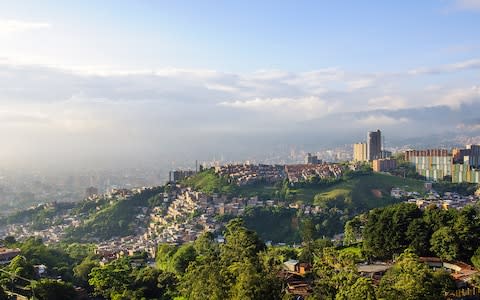Which was the world's most visited country in 2018?

With just one week until we bid farewell to 2018, it feels an opportune time to look at the countries that thrust themselves onto travel radars over the last 12 months – and those that slipped from the spotlight.
The story for several nations was one of continued recovery. Take Turkey. It endured a year to forget in 2015, when security concerns saw visitor numbers fall from 39.5m to 30.3m. Last year it clawed back much of that ground, with 37.6m overseas tourists exploring its ancient sites or flopping on one of its beaches. This year looks certain to be its biggest yet, with the United Nations World Tourism Organisation (UNWTO) forecasting 46m visitors, an increase of 22.4 per cent. That’s based on figures up to and including September - the exact total won’t be known until early next year - and it should be enough to see Turkey leapfrog the UK and Mexico to become the world’s sixth most visited country.
Tunisia is also resurgent. The terror attack in Sousse saw visitor numbers fall to 5.4m in 2015. They steadied to 5.7m in 2016, rose to 7.1m last year, and are expected to increase again to around 8.3m for 2018 (up 16.9 per cent).
But which was the world’s fastest growing travel destination in 2018? As outlined above, the final figures will not be confirmed for a few months – but the majority of countries have supplied the UNWTO with data for the first nine months of the year (others, such as the US, Ukraine and Saudi Arabia, appear less prompt when it comes to border bureaucracy).
And topping the chart for year-on-year growth is a South American nation that’s home to an Avenue of Volcanoes and a train journey called The Devil’s Nose. It’s Ecuador.

The country is predicting an increase in visitor numbers of 56.1 per cent, from 1.6m to around 2.5m, and appears to be reaping the rewards of a long-term plan to boost tourism through increased marketing. However, fears have been raised this year that “overtourism” may be putting Ecuador’s biggest draw, the Galapagos Islands, at risk. There is currently a cap on the number of cruise ships that can visit the remote archipelago but land-based tours are not so tightly controlled.
Ecuador’s neighbour, Colombia, is also experiencing a tourism boom (up 32.8 per cent from 4m to 5.3m), something many have put down to the popularity of the Netflix series Narcos. Telegraph Travel reported earlier this year on how Medellin has transformed itself from murder capital to hipster holiday destination. “Today Medellin feels new-born,” wrote Stanley Stewart. “It helps that the setting is gorgeous. The city lies in a long valley between two Andean mountain ridges. Capital of Antioquia province, a fertile region famous for its coffee plantations and its flower farms, for its orchids and butterflies, it is known as the City of Eternal Spring for its idyllic climate. Everywhere you turn there seem to be new things happening.”

Vietnam’s meteoric rise goes on, driven largely by waves of visitors from China. Back in 1990 just 250,000 foreigners visited. That figure grew to 3.5m in 2005, 5m in 2010 and 7.9m in 2015. Last year 12.9m went to Vietnam; this year it will be around 15.8m (up 22.4 per cent).
After Turkey, Europe’s fastest growing destination is Albania (up 19.8 per cent to 5.5m). Perhaps sunseekers were inspired by Telegraph Travel’s glowing report in February that described it as Eastern Europe’s answer to the Amalfi Coast?
The tiny island of Tuvalu appears near the top of the table – but it only had 2,000 visitors last year, so that 35.5 per cent increase will only amount to some 700 extra travellers. It is still the least visited nation on the planet, according to UNWTO – head there for serious bragging rights.
Where are visitor number falling?
There were losers in 2018, as well as winners – including the UK. The first six months of the year saw a fall in arrivals of 6.8 per cent. Should that trend continue for the whole of 2018, arrivals will drop from 37.7m to 35.1m. Early indications suggest no other major tourist destination has experienced a bigger slump.
Several minnows have seen a steeper drop, including Timor-Leste (-17.7 per cent, up to and including June) and Papua New Guinea (-26.5 per cent, to June).
Anguilla was hit by Hurricane Irma, so its 49 per cent fall in visitors (up to July) is unsurprising. So too is St Maarten’s 74.8 per cent decline (to June).
Political unrest hit Nicaragua this year, contributing to a 26.7 per cent fall in visitors (to September).

Which was the most visited country in 2018?
The final figures are not confirmed, but France appears certain to retain its title as the most visited country on the planet. Projections show around 93.8m people travelled to the country this year, up 7.9 per cent on 2017.
In fact, it would appear that the 20 most visited countries last year will remain the 20 most visited countries of 2018. But there could be movement in the table.
The US, which lost second spot to Spain in 2017, may well regain it. Forecasts predict an increase of 6.9 per cent in arrivals to the US, which would bump it up to 82.2m, ahead of Spain, which is expected to show little or no growth on the 81.8m who visited last year.
The UK may well tumble down the table from seventh to 10th, with Turkey, Germany and Thailand all moving up.
Japan is expected to leapfrog Austria into 11th; Greece to jump above Hong Kong into 13th; and Netherlands to swap places with Poland.
France - 93.8m (=)
US - 82.2m (+1)
Spain - 81.8m (-1)
China - 61.9m (=)
Italy - 61m (=)
Turkey - 46m (+2)
Mexico - 42m (-1)
Germany - 38.9m (+1)
Thailand - 38.3m (+1)
UK - 35.1m (-3)
Japan - 31.7m (+1)
Austria - 30.7m (-1)
Greece - 30m (+1)
Hong Kong - 29.3 (-1)
Malaysia - 25.8m (=)
Russia - 24.4m (=)
Portugal - 21.2m (=)
Canada - 21m (=)
Netherlands - 19.1m (+1)
Poland - 18.4 (-1)

And which was the most visited city?
Euromonitor International’s analysis shows Hong Kong leading the way with 29.8m arrivals forecast for 2018 (up seven per cent), followed by Bangkok (23.7m; up 5.5 per cent) and London (20.7m; up 4.5 per cent). The UK capital’s closest European rivals are Paris (sixth, with 16.9m visitors) and Istanbul (12th with 12.1m).
It appears Asian cities are climbing the table largely at the expense European ones.
Chennai (45th overall), cricket obsessed, and a surprising coffee capital; Agra (29th), home to the world’s most beautiful building; and thrilling but undeniably chaotic Delhi (13th), are projected growth of 30.4 per cent, 24.3 per cent and 23.1 per cent, respectively.
Conversely, Rome will fall three places in 2018 (to 18th), Venice will lose four positions (now 45th), and Florence two (now 49th). Berlin’s 2018 ranking is 36th (down two spots).
But Euromonitor also highlighted Porto’s surge up the rankings. It has advanced 42 places since 2012 to reach the top 100 for the first time this year.